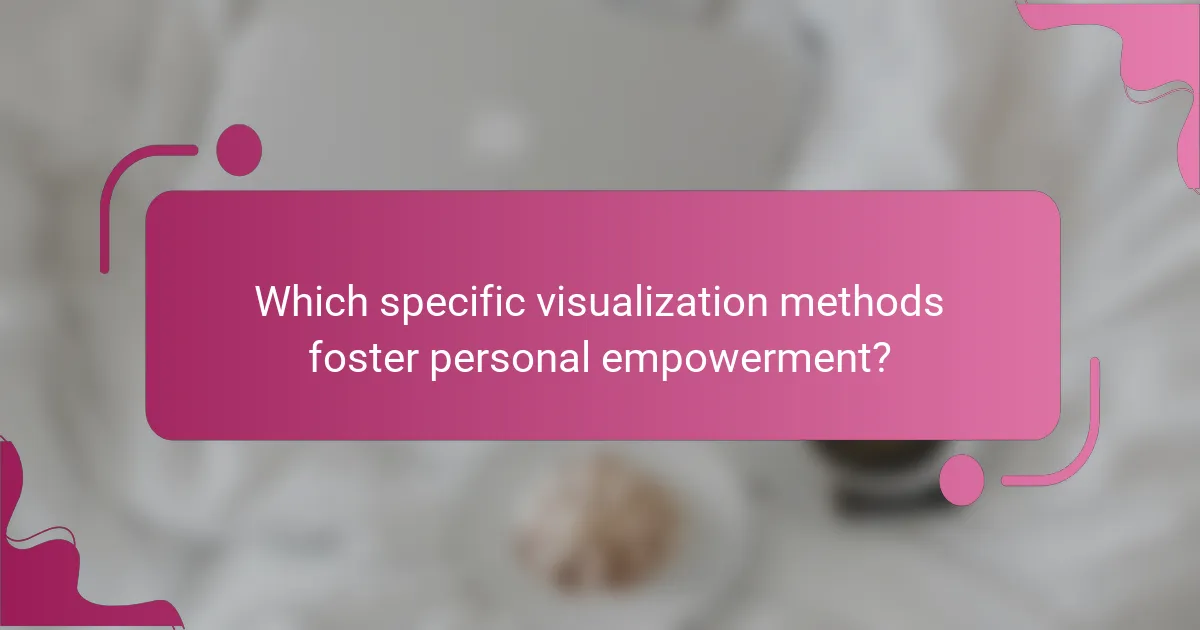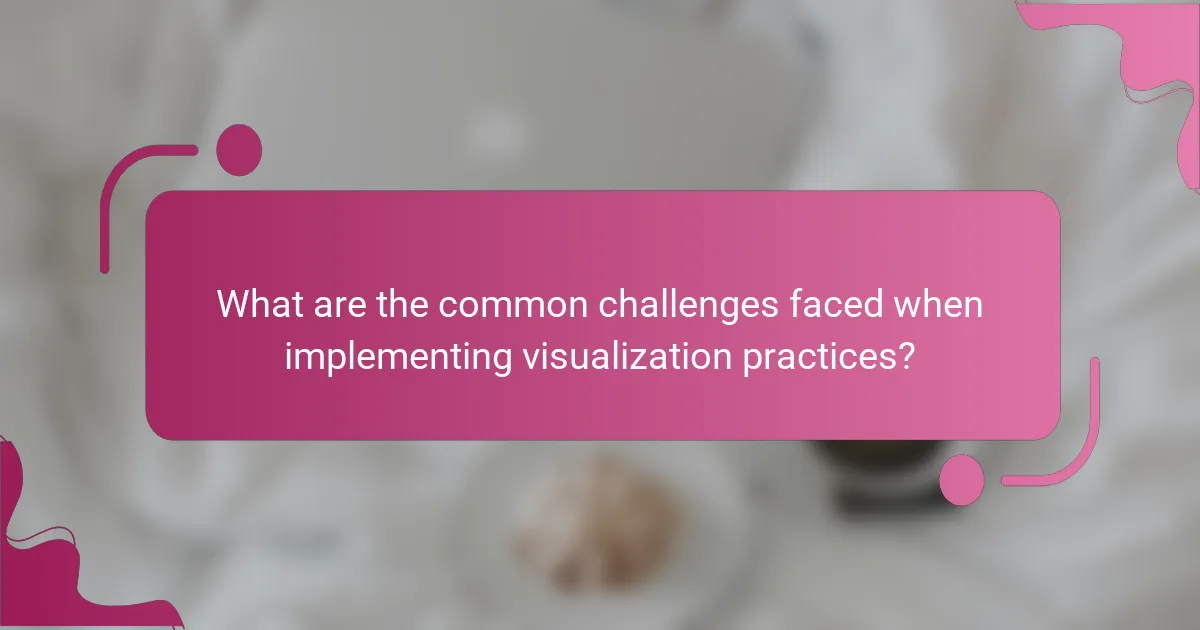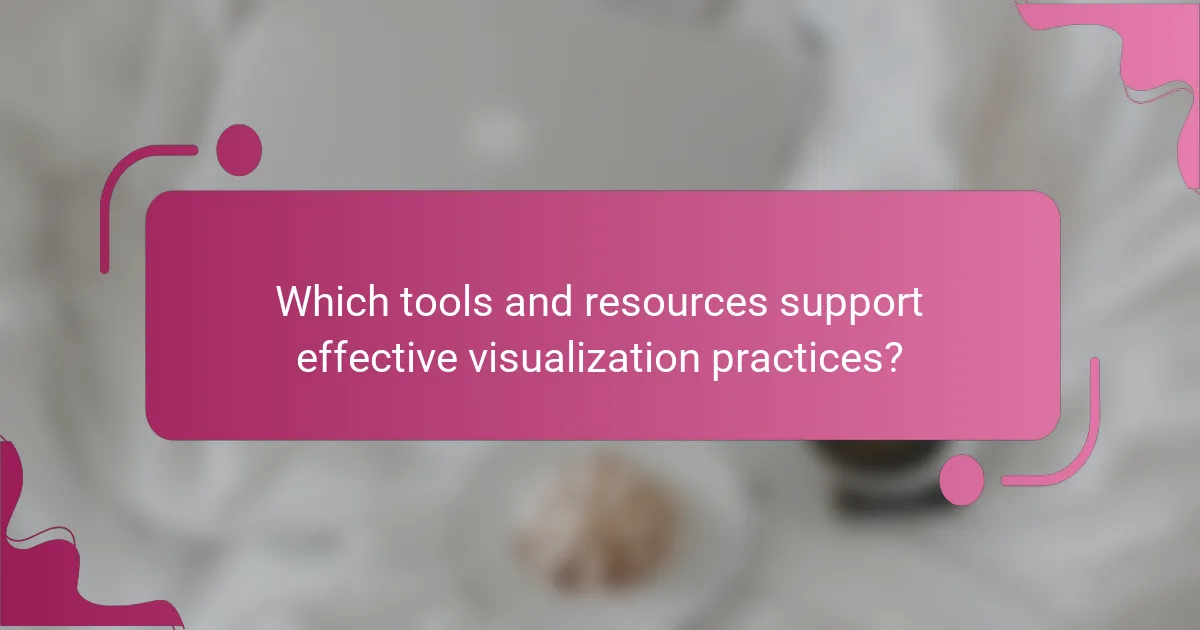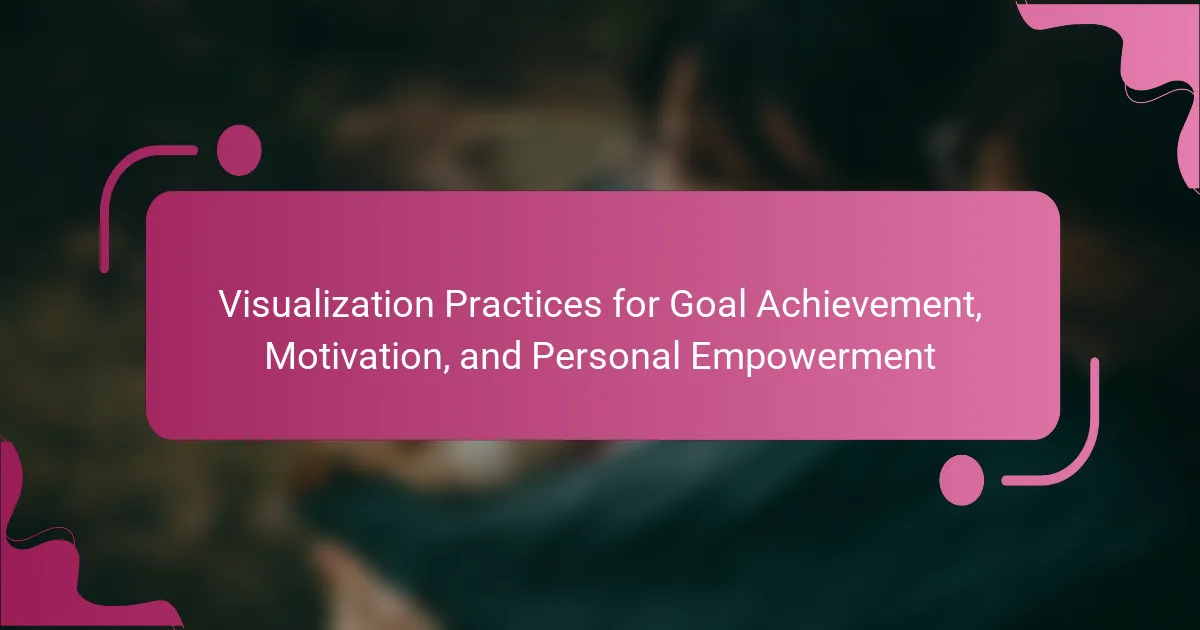Visualization practices enhance goal achievement by improving clarity, focus, and motivation. They foster personal empowerment through methods like vision boards and guided imagery. Cultural context shapes how individuals visualize success and face challenges in implementation. Various tools and resources support these practices, boosting motivation and facilitating personal growth.

How do visualization practices enhance goal achievement?
Visualization practices significantly enhance goal achievement by fostering clarity, focus, and motivation. By mentally picturing success, individuals create a strong emotional connection to their objectives, which can increase persistence and drive. Research indicates that visualization can improve performance by up to 25% in various fields, demonstrating its effectiveness. This practice not only boosts confidence but also helps in overcoming obstacles by preparing the mind for potential challenges. Ultimately, visualization serves as a powerful tool for personal empowerment and goal realization.
What psychological mechanisms underpin visualization for success?
Visualization enhances motivation and personal empowerment by leveraging psychological mechanisms such as mental imagery, goal-setting, and self-efficacy. Mental imagery activates brain regions associated with actual performance, improving confidence and focus. Goal-setting clarifies objectives, making them more attainable, while self-efficacy fosters belief in one’s abilities. These mechanisms work together to create a positive feedback loop, reinforcing the desire to achieve and maintain success.
Which visualization techniques are most effective for different goals?
Different visualization techniques effectively support various goals such as clarity, motivation, and empowerment. For goal achievement, techniques like goal-setting charts and progress trackers provide visual clarity. Mind maps enhance motivation by visually organizing thoughts and ideas. Infographics can empower individuals by presenting complex information simply. Data visualizations, such as bar graphs and pie charts, are effective for illustrating performance metrics. Each technique serves a unique purpose in achieving personal and professional objectives.
How does visualization impact performance and outcomes?
Visualization significantly enhances performance and outcomes by improving focus, motivation, and self-efficacy. It enables individuals to mentally rehearse success, leading to increased confidence and clarity in goal achievement. Studies show that athletes using visualization techniques often outperform those who do not, highlighting its effectiveness in various fields. Visualization practices create a mental blueprint, allowing for better preparation and execution of tasks.

What role does motivation play in visualization practices?
Motivation is crucial in visualization practices as it drives engagement and persistence toward goals. High motivation enhances the effectiveness of visualization, enabling individuals to better envision their success and maintain focus. Visualization acts as a motivational tool, reinforcing positive beliefs and emotions, which can lead to improved performance and personal empowerment. By consistently visualizing desired outcomes, individuals can cultivate a strong sense of purpose and commitment, ultimately facilitating goal achievement.
How can visualization boost intrinsic motivation?
Visualization significantly enhances intrinsic motivation by creating a vivid mental picture of goals. This practice fosters a sense of ownership and personal empowerment. When individuals visualize success, they activate emotional responses that reinforce commitment. Studies show that mental imagery can increase motivation by up to 30%. Visualization also helps in overcoming obstacles by mentally rehearsing solutions, making challenges feel more manageable. By regularly engaging in visualization, individuals can maintain focus and drive toward their objectives.
What are the external factors that influence motivation in visualization?
External factors that influence motivation in visualization include social support, environmental cues, cultural beliefs, and personal experiences. These factors can enhance or diminish the effectiveness of visualization practices for goal achievement and personal empowerment. Social support from peers or mentors can boost confidence and motivation. Environmental cues, such as visual reminders of goals, can reinforce commitment. Cultural beliefs shape the perception of success and failure, impacting motivation levels. Personal experiences, including past successes or failures, create emotional connections that influence future motivation.

Which specific visualization methods foster personal empowerment?
Visualization methods that foster personal empowerment include vision boards, guided imagery, and affirmations. These practices enhance motivation and clarify goals, leading to increased self-efficacy. Vision boards visually represent aspirations, while guided imagery helps individuals mentally rehearse success. Affirmations reinforce positive beliefs, creating a supportive mindset for goal achievement. These methods collectively contribute to a sense of control and personal growth.
How can visualization techniques be tailored for individual empowerment journeys?
Visualization techniques can be tailored for individual empowerment journeys by personalizing the process to align with specific goals and motivations. Tailored visualization enhances focus, increases motivation, and fosters a sense of ownership over personal development.
Individuals can begin by identifying their unique aspirations and challenges. For example, someone aiming to improve public speaking skills might visualize themselves confidently presenting in front of an audience. This unique attribute of visualization makes the practice more relevant and impactful.
Incorporating sensory details into the visualization process strengthens the experience. Engaging multiple senses can evoke emotions, making the visualization more vivid and effective. This approach taps into the rare attribute of emotional resonance, which can significantly enhance motivation.
Regular practice and reflection are crucial for maximizing the benefits of tailored visualization. Setting aside dedicated time for visualization can reinforce commitment to personal goals, creating a sustainable empowerment journey.
What are the differences in empowerment outcomes across various visualization styles?
Different visualization styles yield varied empowerment outcomes by influencing user engagement and motivation levels. For instance, interactive visuals enhance personal agency, while static graphs may limit emotional connection.
| Visualization Style | Engagement Level | Empowerment Outcome |
|———————|——————|——————————–|
| Interactive Charts | High | Increased personal agency |
| Infographics | Moderate | Improved understanding |
| Static Graphs | Low | Limited emotional connection |
| Mind Maps | High | Enhanced creativity and clarity |
| Dashboards | Moderate | Quick insights and motivation |
| Storytelling Visuals | High | Strong emotional resonance |

How does cultural context affect visualization practices?
Cultural context significantly influences visualization practices by shaping individual goals, motivations, and empowerment strategies. Different cultures prioritize various values, which affect how people visualize success and personal growth. For example, collectivist cultures may emphasize community-oriented goals, while individualistic cultures focus on personal achievements. Additionally, cultural narratives and symbols can enhance motivation by resonating with personal identities. Understanding these cultural nuances enables more effective visualization techniques tailored to diverse backgrounds, enhancing goal achievement and personal empowerment.
What regional differences exist in the adoption of visualization techniques?
Regional differences in the adoption of visualization techniques are significant and influenced by cultural, economic, and educational factors. In North America, visualization practices are widely integrated into business and personal development, emphasizing goal achievement and motivation. In contrast, European countries often focus on educational applications, using visualization for learning enhancement and cognitive development.
In Asia, visualization techniques are increasingly popular in mindfulness and mental health, aligning with traditional practices. African regions show a growing interest in visualization as a means for personal empowerment, often linked to community development initiatives. These variations highlight how local contexts shape the adoption and application of visualization techniques.
How do cultural beliefs shape the effectiveness of visualization?
Cultural beliefs significantly influence the effectiveness of visualization practices by shaping individual perceptions and motivations. These beliefs determine how people interpret visualized goals, affecting their commitment and emotional connection. For instance, cultures that emphasize collective success may motivate individuals to visualize group achievements, enhancing motivation. Conversely, individualistic cultures may focus on personal milestones, leading to different visualization techniques. Additionally, cultural narratives can reinforce positive outcomes, making visualization more impactful. Understanding these cultural dimensions allows for tailored visualization approaches that resonate with diverse audiences.

What are the common challenges faced when implementing visualization practices?
Common challenges in implementing visualization practices include lack of clarity in goals, resistance to change, and insufficient training. Many individuals struggle to define specific objectives, which hampers effective visualization. Resistance from team members can undermine commitment to these practices. Additionally, without proper training, users may not fully utilize visualization tools, limiting their potential for goal achievement and personal empowerment.
How can individuals overcome skepticism towards visualization?
Individuals can overcome skepticism towards visualization by practicing consistent and intentional techniques. Engaging in visualization regularly builds familiarity and trust in the process. Combining visualization with actionable steps enhances belief in its effectiveness. Seeking evidence through testimonials and research can also validate its benefits, reinforcing motivation and personal empowerment.
What are the misconceptions about visualization that hinder its effectiveness?
Misconceptions about visualization often limit its potential. Many believe visualization is merely daydreaming or wishful thinking, neglecting its role in goal achievement. Others think it requires artistic talent, while effective visualization relies on clarity of intention and mental imagery. Additionally, some assume that visualization alone guarantees success, overlooking the importance of action and persistence. Finally, there is a belief that visualization is a one-time practice, when in reality, consistent reinforcement enhances its effectiveness.

Which tools and resources support effective visualization practices?
Visualization practices can be effectively supported by various tools and resources that enhance goal achievement and personal empowerment. Key tools include digital platforms like Trello for task management, Canva for visual content creation, and MindMeister for mind mapping. Resources such as guided visualization exercises, motivational podcasts, and books on personal development also play a crucial role. These tools and resources help clarify goals, boost motivation, and foster a sense of empowerment through structured visualization techniques.
What digital platforms facilitate visualization for goal achievement?
Digital platforms that facilitate visualization for goal achievement include tools that enhance motivation and personal empowerment. Popular options are Trello, which allows visual task management, and Canva, which helps create visual representations of goals. Additionally, MindMeister offers mind mapping for brainstorming ideas. Other platforms like Notion and Asana support goal tracking with visual elements. These tools leverage visualization to improve focus and clarity, aiding users in achieving their objectives effectively.
How can guided visualization resources enhance personal empowerment?
Guided visualization resources enhance personal empowerment by fostering clarity, focus, and motivation. These practices help individuals visualize their goals, leading to increased confidence and a stronger sense of agency. Visualization techniques can improve emotional resilience, enabling users to overcome challenges and setbacks. Engaging with these resources regularly cultivates a proactive mindset, encouraging personal growth and achievement.
What role do community and support networks play in visualization success?
Community and support networks significantly enhance visualization success by providing motivation, accountability, and shared experiences. These networks foster a sense of belonging and encouragement, which can amplify personal empowerment. Individuals who engage with supportive communities often report increased commitment to their goals and improved outcomes. The emotional and practical support received can help overcome obstacles, making visualization practices more effective.
What are best practices for integrating visualization into daily routines?
Integrating visualization into daily routines enhances goal achievement and personal empowerment. Start by setting clear intentions for your visualization practice.
1. Schedule daily visualization sessions, ideally in the morning when your mind is fresh.
2. Create a dedicated space free from distractions to enhance focus.
3. Use visualization techniques that resonate with you, such as guided imagery or vision boards.
4. Incorporate sensory details to make your visualizations more vivid and compelling.
5. Reflect on your visualizations regularly to track progress and adjust goals as needed.
These practices foster a stronger connection to your aspirations and maintain motivation.
What common mistakes should be avoided in visualization practices?
Avoiding common mistakes in visualization practices enhances goal achievement and personal empowerment. Key mistakes include lack of clarity, overcomplicating visuals, neglecting the audience’s needs, and failing to update visuals as goals evolve.
Clarity is essential; visuals should convey messages without confusion. Overcomplicated designs can distract from the main goal. Understanding the audience ensures that visuals are relevant and motivating. Regular updates maintain alignment with changing objectives, reinforcing motivation and empowerment.
